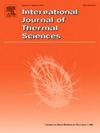热-力耦合对砂质粉土导热性的影响:来自核磁共振和扫描电镜分析的见解
IF 5
2区 工程技术
Q1 ENGINEERING, MECHANICAL
International Journal of Thermal Sciences
Pub Date : 2025-07-23
DOI:10.1016/j.ijthermalsci.2025.110175
引用次数: 0
摘要
现有的研究多集中于对冻土导热系数的分析,很少从微观角度揭示冻土导热系数变化的机理。本文在冻融条件下砂质粉土导热系数试验的基础上,通过核磁共振(NMR)和扫描电镜(SEM)测试揭示了砂质粉土微观孔隙结构特征。结果表明,砂质粉土的热导率与未冻水含量和冰含量的动态变化密切相关,其中-5℃是未冻水含量突然下降和冰含量接近饱和的关键转折点,冻融砂质粉土的热导率可分为快速增长趋势(20℃~ -5℃)和缓慢增长趋势(- 10℃~ -30℃)。从微观角度看,这一趋势与孔径分布、颗粒表面形貌和颗粒接触状态三个因素密切相关。在快速生长趋势阶段,砂质粉土内部微孔所占比例较大,微孔的填充作用提高了土体的整体连通性。颗粒表面形貌逐渐由尖向圆转变,颗粒间接触面积增大。同时,该阶段颗粒的接触状态由松散变为致密,进一步优化了传热路径。这三个因素都起到了促进作用。在缓慢增长趋势阶段,砂质粉土的大孔隙增加较大(比未冻结时增加了0.5%),颗粒的表面形态和接触状态趋于较好。但由于砂质粉土中未冻水的冰点较高,无法实时通过水迁移提供补水,导致含冰量减少,形成大孔结构,这种缺陷的孔隙网络虽然伴随着颗粒接触或颗粒表面形貌的改善,但难以构建连续高效的导热通道。该研究揭示了宏观导热系数变化与微观结构特征之间的内在联系,为从微观层面解释导热系数变化提供了基本指导。本文章由计算机程序翻译,如有差异,请以英文原文为准。
Effects of thermal-mechanical coupling on the thermal conductivity of sandy silt: insights from NMR and SEM analysis
Existing studies mostly focus on the analysis of the thermal conductivity of frozen soil, and few reveal the mechanism of thermal conductivity change from a microscopic perspective. In this paper, based on the thermal conductivity test of sandy silt under freeze-thaw conditions, the microscopic pore structure characteristics were revealed by the nuclear magnetic resonance (NMR) and scanning electron microscope (SEM) tests. The results demonstrated that the thermal conductivity of sandy silt was closely related to dynamic changes in unfrozen water content and ice content, in which −5 °C was the key turning point of the sudden drop of unfrozen water content and the ice content close to saturation, and the thermal conductivity of freeze-thawed sandy silt could be divided into the rapid growth trend (20 °C ∼ -5 °C) and the slow growth trend (−10 °C ∼ -30 °C). From the microscopic point of view, this trend was closely related to three factors: pore size distribution, particle surface morphology, and particle contact state. During the rapid growth trend stage, the micropores inside the sandy silt accounted for a larger proportion, and the filling effect of micropores improved the overall connectivity of the soil body. The surface morphology of particles gradually changed from sharp to rounded, which increased the contact area between particles. Meanwhile, the contact state of the particles in this stage changed from loose to dense, further optimizing the heat transfer path. All three factors played a facilitating role. During the slow growth trend stage, the increase in macropores of sandy silt was larger (up to 0.5 % compared to unfrozen), and the surface morphology and contact state of the particles tended to be relatively good. However, due to the high freezing point of unfrozen water in the sandy silt, it was not possible to provide water recharge through water migration in real-time, which led to the decrease of ice content and the development of macroporous structure, and this defective pore network was difficult to construct continuous and efficient thermal conductivity channels, although it was accompanied by the improvement of particle contact or particle surface morphology. This study reveals the intrinsic relationship between the variation of macroscopic thermal conductivity and the micro-structure characteristics and provides a basic guideline for explaining the variation of thermal conductivity from the microscopic level.
求助全文
通过发布文献求助,成功后即可免费获取论文全文。
去求助
来源期刊

International Journal of Thermal Sciences
工程技术-工程:机械
CiteScore
8.10
自引率
11.10%
发文量
531
审稿时长
55 days
期刊介绍:
The International Journal of Thermal Sciences is a journal devoted to the publication of fundamental studies on the physics of transfer processes in general, with an emphasis on thermal aspects and also applied research on various processes, energy systems and the environment. Articles are published in English and French, and are subject to peer review.
The fundamental subjects considered within the scope of the journal are:
* Heat and relevant mass transfer at all scales (nano, micro and macro) and in all types of material (heterogeneous, composites, biological,...) and fluid flow
* Forced, natural or mixed convection in reactive or non-reactive media
* Single or multi–phase fluid flow with or without phase change
* Near–and far–field radiative heat transfer
* Combined modes of heat transfer in complex systems (for example, plasmas, biological, geological,...)
* Multiscale modelling
The applied research topics include:
* Heat exchangers, heat pipes, cooling processes
* Transport phenomena taking place in industrial processes (chemical, food and agricultural, metallurgical, space and aeronautical, automobile industries)
* Nano–and micro–technology for energy, space, biosystems and devices
* Heat transport analysis in advanced systems
* Impact of energy–related processes on environment, and emerging energy systems
The study of thermophysical properties of materials and fluids, thermal measurement techniques, inverse methods, and the developments of experimental methods are within the scope of the International Journal of Thermal Sciences which also covers the modelling, and numerical methods applied to thermal transfer.
 求助内容:
求助内容: 应助结果提醒方式:
应助结果提醒方式:


